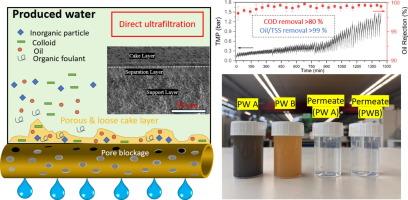Oilfield-produced water treatment with SiC-coated alumina membranes
IF 8.1
1区 工程技术
Q1 ENGINEERING, CHEMICAL
引用次数: 0
Abstract
During the extraction of fossil fuels, a complex waste stream is produced simultaneously, also known as produced water (PW). Membrane filtration is a promising technology that can successfully enable the treatment and reuse of PW. Silicon carbide (SiC) membranes are preferred for PW treatment, due to their low (ir)reversible fouling compared to other ceramic membranes. However, full SiC is expensive and thus economically less feasible. Therefore, we established a method for coating SiC on alumina (Al2O3) ultrafiltration membranes, based on low-pressure chemical vapor deposition at 860 °C. In the presented study the fouling resistance and behavior of these novel membranes, with various pore sizes and under different operating conditions, including flux and crossflow velocity, were evaluated. We also used Al2O3 membranes and SiC-coated Al2O3 membranes in constant flux mode to treat real oilfield PW with high salinity (142 mS/cm) and COD (22670 mg/L). Additionally, the fouling mechanisms in the SiC-coated and Al2O3 membranes were analyzed with the help of Focused Ion Beam-Scanning Electron Microscopy imaging. The major findings were that pore blockage served as the initial (irreversible) fouling mechanism and that the (reversible) cake layer, a mixture of organic and inorganic components, dominated the rest of the filtration cycle, where the SiC coated membrane performed better than the original alumina membrane. In addition, it was found that the application of the SiC coating, and the selection of the appropriate pore size (62 nm) and crossflow velocity (0.8 m/s) increased the fouling mitigation, potentially advancing the utilization of ultrafiltration in treating saline PW for resue purposes.

求助全文
约1分钟内获得全文
求助全文
来源期刊

Separation and Purification Technology
工程技术-工程:化工
CiteScore
14.00
自引率
12.80%
发文量
2347
审稿时长
43 days
期刊介绍:
Separation and Purification Technology is a premier journal committed to sharing innovative methods for separation and purification in chemical and environmental engineering, encompassing both homogeneous solutions and heterogeneous mixtures. Our scope includes the separation and/or purification of liquids, vapors, and gases, as well as carbon capture and separation techniques. However, it's important to note that methods solely intended for analytical purposes are not within the scope of the journal. Additionally, disciplines such as soil science, polymer science, and metallurgy fall outside the purview of Separation and Purification Technology. Join us in advancing the field of separation and purification methods for sustainable solutions in chemical and environmental engineering.
 求助内容:
求助内容: 应助结果提醒方式:
应助结果提醒方式:


